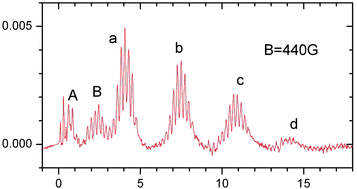Magnetic field effect on the free induction decay of hydroxyl radicals (OH) in the terahertz region†
Abstract
The effect of an external longitudinal magnetic field on the optical free induction decay from a free radical is observed for the first time. The experiments were performed on a rotational transition of the hydroxyl radical, OH (2Π3/2(J = 1) ← 2Π3/2(J = 0) at 83.8 cm−1), using a terahertz free electron laser. In contrast to the results of the experiments with a stable paramagnetic molecule, NO, the observed effect of an external magnetic field on the free induction decay from hydroxyl radicals is more complicated. A longitudinal magnetic field leads to the rotation of the polarization plane of the FID radiation and to an additional modulation of the signal intensity. The angle of the rotation of the plane of polarization is large, in agreement with the theoretical predictions. The observed FID kinetics in the time domain are in semi-quantitative agreement with the modeling. This observation opens an opportunity for the selective detection of weak signals of short-lived reactive paramagnetic free radicals from overwhelming signals that originate from stable non-paramagnetic species by polarization discrimination.

- This article is part of the themed collection: 2020 PCCP HOT Articles


 Please wait while we load your content...
Please wait while we load your content...